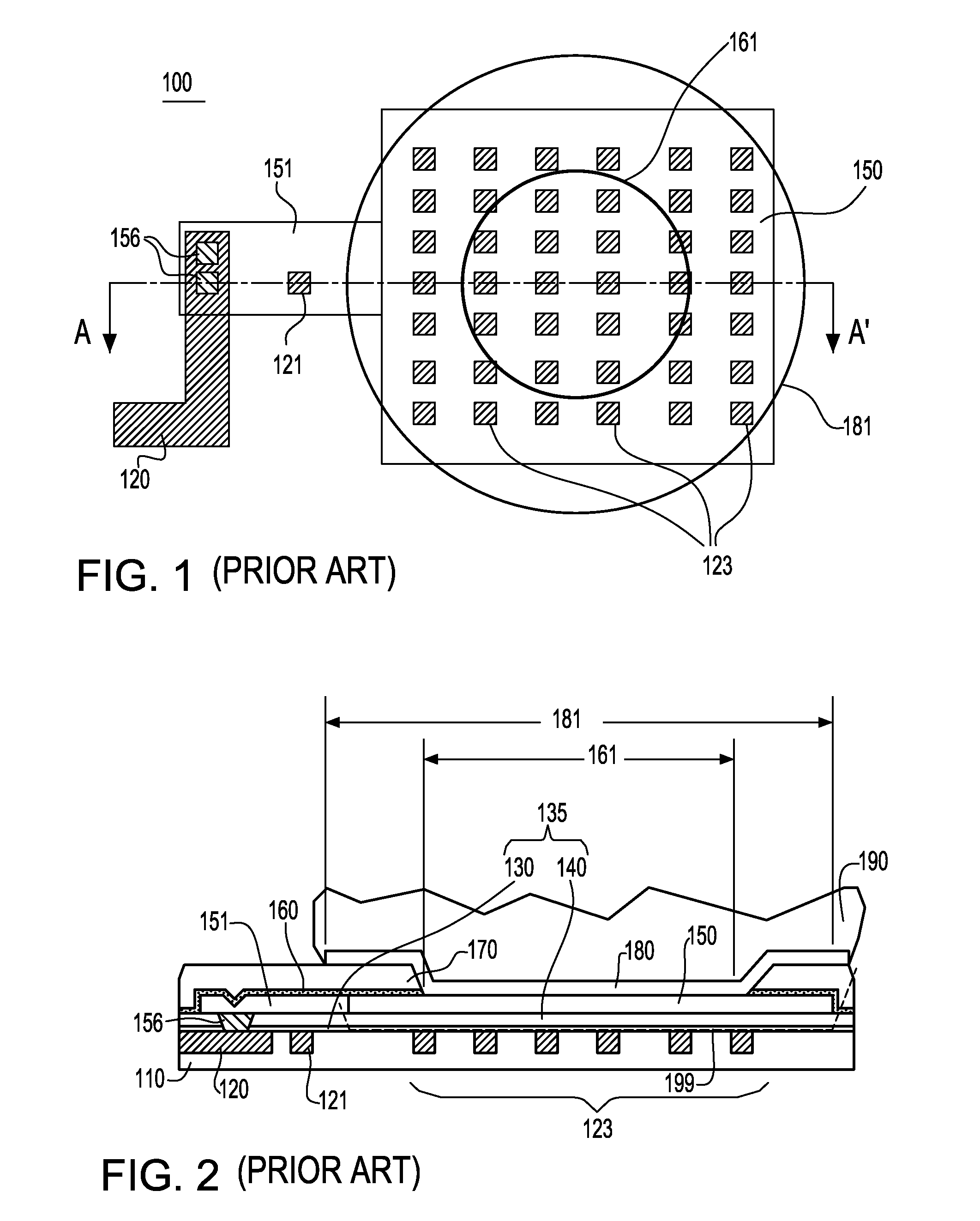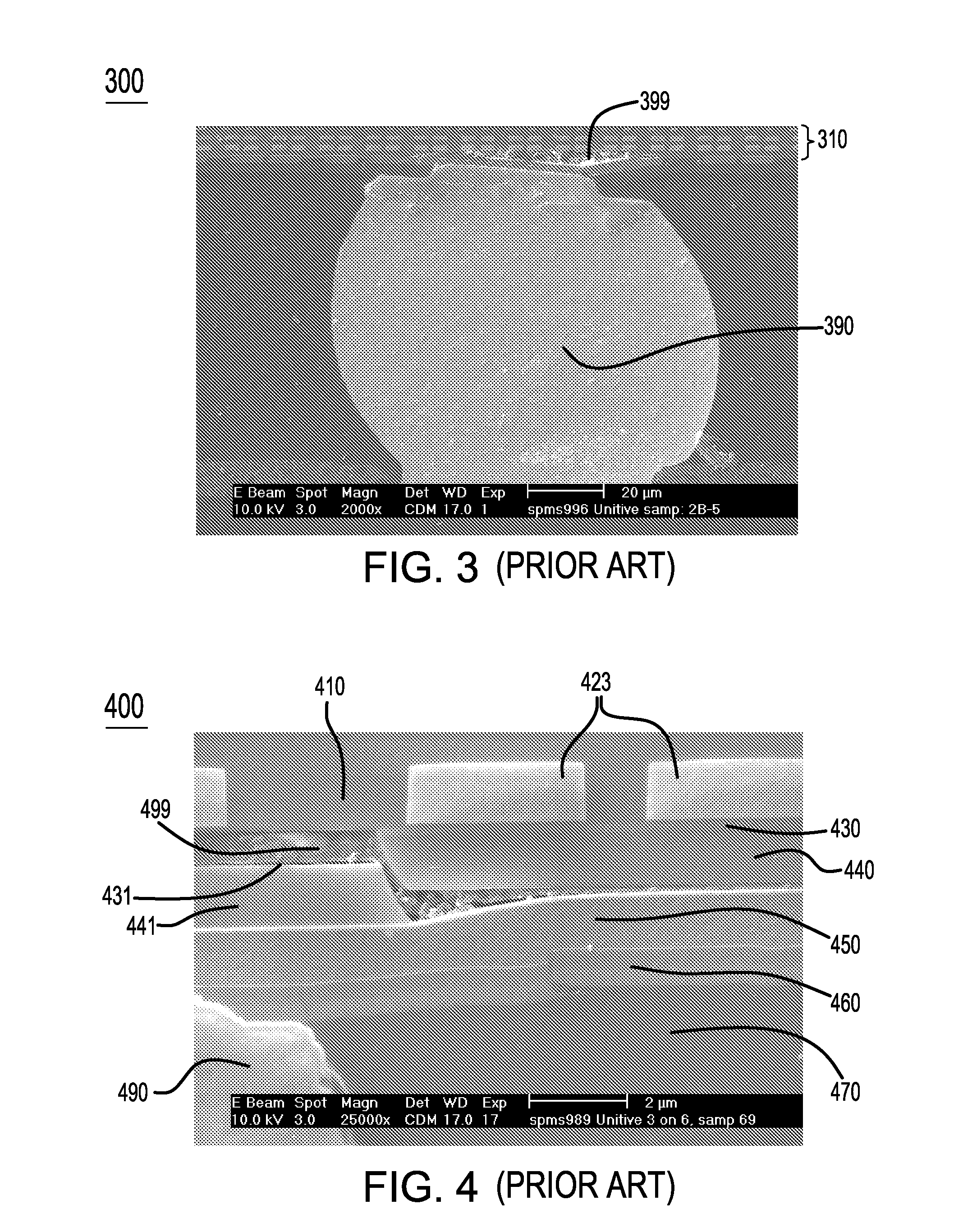Structure and method for enhancing resistance to fracture of bonding pads
a technology of bonding pads and structures, applied in the field of semiconductor structures, can solve the problems of lack of bonding pad area for wiring purposes, failure of the bonding pad, slow degradation and reliability, etc., and achieve the effects of improving the flexibility of wiring, facilitating the cmp process, and enhancing the flexibility of metal wiring
- Summary
- Abstract
- Description
- Claims
- Application Information
AI Technical Summary
Benefits of technology
Problems solved by technology
Method used
Image
Examples
first embodiment
[0049]According to the present invention, a first bond pad structure 500 is described in FIGS. 5-6. FIG. 5 is a schematic top-down view, while FIG. 6 is a schematic cross-sectional view along the line B-B′ in FIG. 5. The first bond pad structure 500 has a first metal pad 550, which is a bond pad, in the first layer of the structure. The area inside the periphery of the first metal pad 550 is referred to as the “pad area.” Only one contiguous first metal pad is necessary for the formation of one of the first bond pad structure 500. The first metal pad 550 is made of metal, and preferably a stack of a liner material and an aluminum alloy. A bond pad extension 551, adjoining the bond pad 550, built on the same level as a bond pad 550, and consisting of the same material as the bond pad, may optionally be constructed as well. The liner material may comprise a stack of tantalum nitride (TaN), titanium (Ti), and titanium nitride (TiN) or an alternate stack of metals with good adhesion pro...
second embodiment
[0064]According to the present invention, the center area 558 of the bond pad structure 700 does not contain any second metal pad 522. All the metal pads are confined within the peripheral area 559. All of the first metal vias 552 are also located within the peripheral area 559. Furthermore, at least one metal structure that does not contact any of the first metal vias 552 is placed within the pad area and at the same level as the second metal pads 522. The metal structure can be either first metal fills 523 or at least one first metal wire 525. None of the first metal fills 523 or any of a portion of the first metal wires 525 is adjoined by any of the first metal vias 552. In other words, there are no metal vias within the pad area that connect any of the metal fills 23 or any of a portion of the first metal wires 525 to the first metal pad 550 above.
[0065]Any of the first metal wires 525 may extend outside the pad area to make electrical connections to other components of the inte...
seventh embodiment
[0075]the present invention enables the use of the pad area at the same level as the second metal pads for wiring the bond pad 550 to the integrated circuit elements below. Alternatively, the second metal wires 524 may be used with existing wiring scheme to reduce the resistance of the circuit wiring path from the bond pad 550.
[0076]According to an eighth embodiment of the present invention, an eighth bond pad structure 1500 is described in a schematic top-down view in FIG. 15. The eighth bond pad structure 1500 according to the present invention shares all the elements of the seventh bond pad structure 1300 according to the seventh embodiment. Furthermore, at least one metal structure that does not contact any of the first metal vias 552 is placed within the pad area and at the same level as the second metal pads 522. The metal structure can be either first metal fills 523 or at least one first metal wire 525. None of the first metal fills 523, nor any of a portion of the first met...
PUM
 Login to View More
Login to View More Abstract
Description
Claims
Application Information
 Login to View More
Login to View More - R&D
- Intellectual Property
- Life Sciences
- Materials
- Tech Scout
- Unparalleled Data Quality
- Higher Quality Content
- 60% Fewer Hallucinations
Browse by: Latest US Patents, China's latest patents, Technical Efficacy Thesaurus, Application Domain, Technology Topic, Popular Technical Reports.
© 2025 PatSnap. All rights reserved.Legal|Privacy policy|Modern Slavery Act Transparency Statement|Sitemap|About US| Contact US: help@patsnap.com



